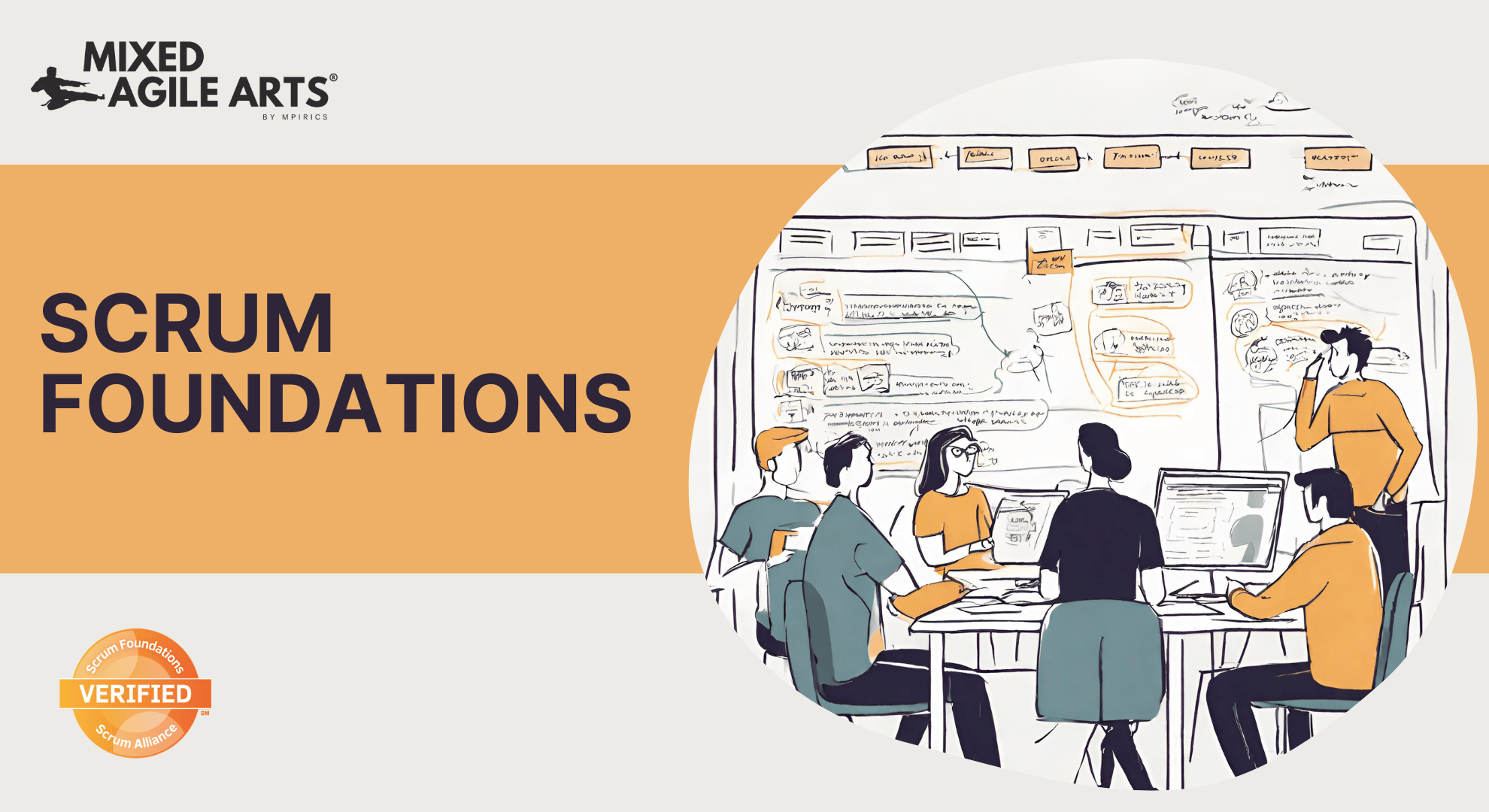Scrum Foundations
What is Scrum and how does it work? Easily get to know the idea and possible applications of Scrum: What is required, what are the benefits and what opportunities are there?
Solid foundational knowledge for your start with Scrum
Get to know Scrum in all of its facets: events, responsibilities (aka roles), artifacts and values. And foremost how these interact to enable agile product development.
What our participants say
4.7

I thought I already knew a lot about Scrum but this training showed me that there is so much more to Scrum!

Now I finally really understand how Scrum works and how I have to use it with my team to make it work. Thank you!

Now I know what we are doing wrong and that we still have a long way to go! But I have a plan 😀

Somewhat long videos, but extremely good content! Thanks for the videos about the events, they helped me a lot. I'm going to do a lot of things differently now.

After the training ...
- understand the theory behind Scrum
- understand the mechanisms of how Scrum elements work together
- know how an agile team works with Scrum
- can create a product backlog
- can conduct a sprint including scrum meetings
- understand what it takes to deliver in the end
- can plan beyond the current sprint
You can expect a journey into the depths and details of Scrum, where you will not only get to know the theory, but also learn exactly how you can put it into practice. With the help of our workbook, you can not only check what you have learned, but you also get to put it into practice!
Online
Learn when you want and where you want! The training is modular and you can consume it from anywhere. All you need is a computer with Internet access.
Self-paced
Do your training at your own pace! Speed and pauses to your liking; reflect on what you have learned whenever you feel it is right and necessary.
Community powered
And you have a community of like-minded learners, trainers and coaches at your side to support and motivate you on your learning journey.
What you will learn
- Why Scrum is a framework and not a method
- what it takes for Scrum to work as such
- the responsibilities of Product Owner, Scrum Master and Developer
- how the Scrum team works together to deliver a product increment
- Product backlog and product target, refinement
- Sprint planning, sprint goal and sprint backlog
- During the sprint, product increment and definition of done
- Sprint Review and Sprint Retrospective
- The Scrum values for successful teamwork
- Planning beyond the scope of a single sprint
We will not leave you alone!
Ask the community
In the Mixed Agile Arts® Community you will get answers to your questions, practical examples and much more during and after the training.
Become a Pro member
Choose the Pro membership to receive many regular events, mentoring from our trainers and exchange with like-minded people. There are also plenty of other online courses available to you.
The contents in detail
Module 1
Hello, Scrum World!
Get to know Scrum: What is it? Where does it come from? What is the difference between Scrum and Agile? What does the name mean? An overview of the most important questions about Scrum. Get to know the Scrum values for successful teamwork.
Module 2
The Scrum Framework
Learn why Scrum is called a framework and how it works. After completing this module, you will not only know the most important elements of the Scrum framework, but also understand how it differs from a process or method.
Module 3
Responsibilities
Get to know the protagonists and understand what Product Owners, Scrum Masters and Developers are responsible for and how these responsibilities differ from one another.
Module 4
Product backlog and product goal
What is needed upfront to the first sprint? Get to know the first artifact of Scrum, the product backlog including the commitment “product goal”. What does a good backlog look like and what does it take to work successfully in sprint planning and the sprint itself?
Module 5
Sprint Planning & Sprint Backlog
How is the sprint planning meeting organized in Scrum and what do good results look like? What is behind the Sprint Backlog artifact and the Sprint Goal? And what is it for? Learn how a team can come up with a good sprint plan.
Module 6
How a sprint works
How does the team work during the sprint? What is the Daily Scrum, what is it for and how is it done correctly? What else happens and what agile practices are necessary to create a product increment? How does the team organize itself in this regard?
Module 7
Sprint Review & Retrospective
A good sprint comes to an end: Learn how a Scrum team learns from the two feedback loops at product and process level and develops improvements for the next sprint. How the two events Sprint Review and Sprint Retrospective work and how they are organized.
Module 8
Planning beyond a sprint
Learn how Scrum teams can plan beyond the horizon of a single sprint and predict what scope can be delivered in what time. Take into account the fundamental idea of agility, accepting changes and taking them into account in planning.
Module 9
Refining the Product Backlog
Learn practices on how to continuously maintain the product backlog as a constantly moving and changing list and how the Scrum team works with its stakeholders to make this process as effective and efficient as possible.
What makes our training so special?
Practical, experienced and professional
Our Scrum Foundations training was put together by Certified Scrum Trainers and Scrum Alliance Certified Agile Coaches. It has been accredited by the Scrum Alliance and fulfills the specified learning objectives. You will receive learning content from Certified Scrum Alliance Trainers (CST, CSAT) who have also committed themselves to the corresponding code Oida!! conduct!
Examples from daily practice
Our training content is based on real examples from the daily practice of Scrum teams under real conditions.
Experts in agility, experts in learning
Because it does matter who you learn from, we have always acquired expertise in human learning.
Much more than just training
In line with our motto "From knowledge to competence", we won't leave you alone on your journey: with support from our community, this is where it all begins.

Any questions?
FAQ
If you cannot find an answer in our FAQs, we will be happy to help you. Simply book an appointment with us!
What is the difference between foundations and essentials?
In our Foundations series, you’ll learn the basics of Scrum (or Kanban), which go much deeper and serve as a foundation for further training programs. For example, the “Certified Scrum Master” (CSM) training course builds on this. So you get solid basic knowledge here.
The Essentials training courses are designed for a “quick start”. So if you only need to know the most important things in a nutshell to get started, the Essentials training is right for you.
However, in order to work successfully in Scrum and actually implement the agile principles and values, there is no way around this Foundations training. In short, “Essentials” is more of a “start-here” when there is very little time; Foundations is “continue-here” when there is more time.
Who is the Scrum Foundations Training for?
If you are serious about using Scrum in your team and no matter what role you will be working in, the knowledge you acquire here is the foundation of your work – hence the name.
The training is therefore intended for agile developers in a Scrum team (including possible organization-specific roles such as architect, tester, business analyst, etc.), product owners and Scrum masters. But it is also important for team leaders and all those in the organization who want to understand how Scrum works.
Are there any prerequisites for participation?
No. You can complete this training without any prior knowledge. However, it is advantageous if you already have an understanding of agile working – you will be better able to internalize the connections and background. We therefore recommend taking our “Agile Foundations” training course in advance.
What are the technical requirements for the training?
You need a computer with a modern Internet browser (Chrome, Safari, Firefox or Edge – always the latest version) or a tablet with the latest version of iOS or Android. The device must be able to play audio and video. So if you can watch YouTube videos with it, it should work 😉
In addition, you need an Internet connection with halfway decent speed (in the sense of the above). So you have to be online to consume the content.